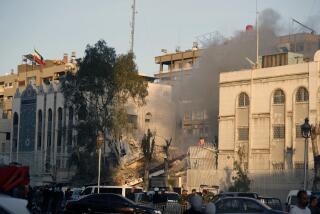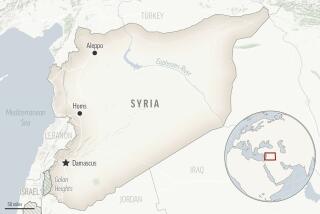Syrian forces pound city; Arab League is turned away
At least 20 Syrians were killed in violence Wednesday, the opposition coalition said, most of them in the central city of Homs where a government military offensive was said to have been launched in response to a series of defections by soldiers who had been deployed to crush civilian protests.
Meanwhile, President Bashar Assad’s government turned back a planned Arab League visit Wednesday in which a request was to have been presented for Assad to stop all violence against civilians immediately and share power until 2014 elections.
In Doha, Qatar, Syrian opposition figures were reported to be debating whether to ask for international intervention to help quell the bloodshed.
By Wednesday afternoon, 17 people had been killed in Homs and three more elsewhere in Syria, according to the Local Coordination Committees of Syria, an opposition coalition. In Homs, “we know that a complete military assault of several neighborhoods is going on,” with loyalist government forces trying to take control of three districts, said Omar Idilbi, a spokesman for the coalition.
Wissam Tarif, a Syrian with the international activist group Avaaz, cited resident accounts from Homs that the gunfire followed defections Tuesday by army soldiers deployed in the three neighborhoods. Those defections had sparked a “clash” between soldiers trying to flee and loyalist mukhabarat, or intelligence agents, trying to stop the defections, Tarif said.
It is impossible to verify the death toll or circumstances because foreign reporters have not been allowed into Syria to independently cover the street protests and government crackdowns.
Since the largely nonviolent protests began six months ago, Assad’s government has employed political-intelligence forces, army troops and armed civilian mercenaries to try to crush the demonstrations and arrest participants. The United Nations reported more than 2,200 deaths by mid-August.
Opposition activists have hoped for wide-scale defections from government forces they say have been ordered to fire on civilian protesters. So far, however, defections appear to have been sporadic.
Homs and the nearby city of Rastan, as well as other restive cities along the Turkish and Jordanian borders, are said to be serving as gathering spots within Syria for fleeing soldiers. Video posted on the Internet late Tuesday purportedly show a few dozen defectors, still in their green army uniforms, speaking to a cheering crowd filling a square and side-streets in Rastan.
Homs residents reported loud explosions Wednesday, some near army checkpoints. With the assault underway, residents largely were unable to venture out to determine what was happening.
“Bombs are going off in the streets, houses are being shelled, gunfire hasn’t ceased,” Majid, a 45-year-old legal worker and activist, said by telephone. “No one knows what is going on. No one knows why and who is shooting at who.”
Many opposition activists and soldiers who have fled argue that Syria’s anti-government movement must remain peaceful, if for no other reason than to avoid giving Assad’s government an excuse to use even greater force.
But the increasing number of reported defections, and the government’s reported response, indicate that mutinies could become a trigger for greater bloodshed.
In Doha, delegates to a 94-member Syrian National Council, formed last month to try to create more visible leadership for the Syrian opposition, continued talks Wednesday. A key issue under debate was whether the Syrian dissidents should seek international intervention, and what form that intervention might take, sources close to the meeting said. Opposition activists in exile tend to be more in favor of intervention than those in Syria.
Syria’s opposition groups have been adamantly opposed to a NATO-style military intervention, such as the one in Libya. But the success of Libya’s rebels in routing longtime leader Moammar Kadafi as NATO air assaults pounded Kadafi’s forces — coupled with the mounting death toll in Syria — have raised some doubt about continuing to go it alone. A few protests have featured banners with slogans calling for a Syrian no-fly zone or other help from the North Atlantic Treaty Organization.
In Damascus, the capital, Syria’s state news agency announced without explanation that the government had withdrawn its invitation for a visit Wednesday by the head of the Arab League.
In Egypt, Arab League officials told reporters that Secretary-General Nabil Elaraby would have presented a plan under which Assad would immediately stop military operations, release all political prisoners, begin dialogue and announce his intention to form a national unity government and hold presidential elections by the end of his term in 2014.
Knickmeyer and Hajjar are special correspondents.
More to Read
Start your day right
Sign up for Essential California for news, features and recommendations from the L.A. Times and beyond in your inbox six days a week.
You may occasionally receive promotional content from the Los Angeles Times.






